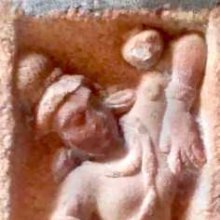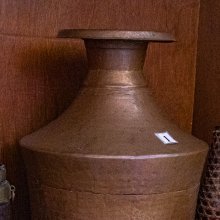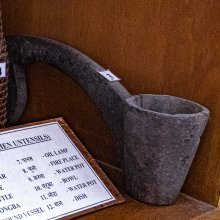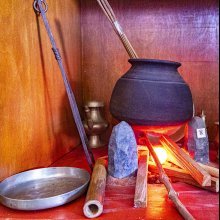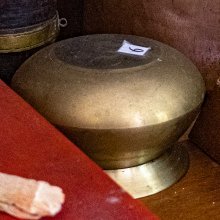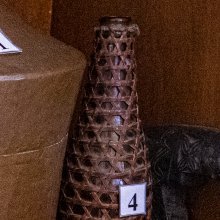Kuta, Kuṭa, Kūṭa, Kūṭā: 35 definitions
Introduction:
Kuta means something in Buddhism, Pali, Hinduism, Sanskrit, Jainism, Prakrit, the history of ancient India, Marathi, Hindi, biology, Tamil. If you want to know the exact meaning, history, etymology or English translation of this term then check out the descriptions on this page. Add your comment or reference to a book if you want to contribute to this summary article.
Images (photo gallery)
(+11 more images available)
In Hinduism
Shaivism (Shaiva philosophy)
Source: murugan: Trimurti Orientation in Medieval South Indian TemplesKūṭa (कूट):—The word, kūṭa, gives several meanings of which one is “the summit or peak of a mountain”. It also means “end” or “corner”. According to the Amarakośa (vv. 1072, 641), kūṭa stands for a heap of grains or the summit of a mountain, synonymous with śikhara or śṛṅga.

Shaiva (शैव, śaiva) or Shaivism (śaivism) represents a tradition of Hinduism worshiping Shiva as the supreme being. Closely related to Shaktism, Shaiva literature includes a range of scriptures, including Tantras, while the root of this tradition may be traced back to the ancient Vedas.
Purana and Itihasa (epic history)
Source: archive.org: Puranic EncyclopediaKūṭa (कूट).—One of the pugilists deputed by Kaṃsa to kill Śrī Kṛṣṇa and Balarāma when they went to Mathurā to witness the dhanuryajña. Cāṇūra, Muṣṭika, Śala and Kosala were the other prominent pugilists deputed by Kaṃsa for the purpose. (Bhāgavata, 10th Skandha).
Source: archive.org: Shiva Purana - English TranslationKūṭa (कूट) refers to “false” (Cf. Kūṭavādī—‘one who is a quibbler’), according to the Śivapurāṇa 2.3.25 (“The seven celestial sages test Pārvatī”).—Accordingly, as the seven Sages said (with false words) to Pārvatī: “O daughter of the mountain, although you are wise and intelligent, you are not able to see through the conduct of that celestial sage who professes to be a great scholar but who is cruel-minded. Nārada is a quibbler [i.e., kūṭa-vādī]. He misleads others. If his words are paid heed to, you stand to lose in every respect. [...]”.
Source: Cologne Digital Sanskrit Dictionaries: The Purana IndexKūṭa (कूट).—A Malla friend of Kaṃsā. Killed by Balarāma.*
- * Bhāgavata-purāṇa X. 42. 37; 44. 26.

The Purana (पुराण, purāṇas) refers to Sanskrit literature preserving ancient India’s vast cultural history, including historical legends, religious ceremonies, various arts and sciences. The eighteen mahapuranas total over 400,000 shlokas (metrical couplets) and date to at least several centuries BCE.
Vastushastra (architecture)
Source: Google Books: Indian Temple Architecture: Form and TransformationKūṭa (कूट).—Representation of a square pavilion (occasionally circular, octagonal or stellate), with domical roof; generally constituting the superstructure of an alpa-vimāna or kūṭa-aedicule.
Source: Shodhganga: Temples of Salem region Up to 1336 ADKūṭa (कूट).—Type of pavillion found sculptured on the hāra (parapet of the temple);—Kūta is a square pavilion. Texts mention that the kūṭa can be circular or octagonal. But only square pavilions are noticed. It is built like any other structure on an elevated and moulded plinth. It consists of four pillars and is covered with a canopy, which is square at the bottom and sloped and rounded in the apex. It is crowned by a single stūpi (finial). The canopy of the kūṭa is to be decorated on all its four sides by alpanāsis. The synonymous term for the kūṭa is “sauṣṭika”.
In the elevation in between the pillars relief sculptures are also often carved. In the parapet, the kūṭa are generally carved at the comers. Therefore, it is called by the name ‘karṇakūṭa’. If the plan of the temple consists of pratikarṇas, at that part also a kūṭa pavilion will be carved in the parapet.
Source: OpenEdition books: Architectural terms contained in Ajitāgama and RauravāgamaKūṭa (कूट) refers to “- 1. decorative aedicule (square) §§ 3.43; 5.8. - 2. lantern (Rau) §§ 4.13, 18, 20, 21. - 3. building similar to a maṇḍapa (Rau) §§ 4.14, 28, 39.”.—(For paragraphs cf. Les enseignements architecturaux de l'Ajitāgama et du Rauravāgama by Bruno Dagens)
Source: Shodhganga: Elements of Art and Architecture in the Trtiyakhanda of the Visnudharmottarapurana (vastu)Kūṭa (कूट) refers to the “top” portion of the Hindu Temple, according to the Viṣṇudharmottarapurāṇa, an ancient Sanskrit text which (being encyclopedic in nature) deals with a variety of cultural topics such as arts, architecture, music, grammar and astronomy.—Kūṭa means the top portion of a building which is situated on the kaṭi i.e., the hip part of the temple. According to the Śabdakalpadruma, kuṭa means small hut. Actually in Hindu temple architecture, small huts in particular shapes are seen to be constructed above the kaṭi portion of a temple. In the Viṣṇudharmottarapurāṇa it is stated that the kūṭa should be four-sided and it should be gradually elevating. Kūṭa should be half of the height of the temple as like the kaṭi i.e., the hip part. Kūṭa can be classified into three divisions having three āmalakasārakas. Āmalakasāraka or āmalaka is a massive circular stone which is figured as the crowning member of the śikhara or the peak of the temple.

Vastushastra (वास्तुशास्त्र, vāstuśāstra) refers to the ancient Indian science (shastra) of architecture (vastu), dealing with topics such architecture, sculpture, town-building, fort building and various other constructions. Vastu also deals with the philosophy of the architectural relation with the cosmic universe.
Ayurveda (science of life)
Nighantu (Synonyms and Characteristics of Drugs and technical terms)
Source: Wisdom Library: Raj NighantuKūṭa (कूट) refers to “peak” or “summit” of a mountain (giri) according to the second chapter (dharaṇyādi-varga) of the 13th-century Raj Nighantu or Rājanighaṇṭu (an Ayurvedic encyclopedia). The Dharaṇyādi-varga covers the lands, soil, mountains [viz., Kūṭa], jungles and vegetation’s relations between trees and plants and substances, with their various kinds.

Āyurveda (आयुर्वेद, ayurveda) is a branch of Indian science dealing with medicine, herbalism, taxology, anatomy, surgery, alchemy and related topics. Traditional practice of Āyurveda in ancient India dates back to at least the first millenium BC. Literature is commonly written in Sanskrit using various poetic metres.
Kavya (poetry)
Source: archive.org: Naisadhacarita of SriharsaKuṭa (कुट) refers to a “tree”, and is mentioned in the Naiṣadha-carita 17.22. Kuṭa, as in kucakuṭa, also refers to a “pot”, as mentioned in the Naiṣadha-carita 18.26.

Kavya (काव्य, kavya) refers to Sanskrit poetry, a popular ancient Indian tradition of literature. There have been many Sanskrit poets over the ages, hailing from ancient India and beyond. This topic includes mahakavya, or ‘epic poetry’ and natya, or ‘dramatic poetry’.
Shaktism (Shakta philosophy)
Source: Google Books: ManthanabhairavatantramKūṭa (कूट) refers to the “Peak (syllable)”, according to the Ṣaṭsāhasrasaṃhitā, an expansion of the Kubjikāmatatantra: the earliest popular and most authoritative Tantra of the Kubjikā cult.—Accordingly, “[...] (The four sacred seats) O JĀ PŪ KĀ (correspond to the four elements) from Earth onwards. The Yoni of Space is the fifth. [...]. Once the division of the Peak (syllable) [i.e., kūṭa-bheda] has been learned, the god Haṃsa should be applied. That man, O lady praised by the heroes, is the destroyer of time (which he does in this) and no other way. There are four syllables for each syllable of the name of (each) seat. The Knots accord with the division (of the syllables of) the seats. (The wise) know that (this is) the arising of the seed-syllable HAṂSA”.

Shakta (शाक्त, śākta) or Shaktism (śāktism) represents a tradition of Hinduism where the Goddess (Devi) is revered and worshipped. Shakta literature includes a range of scriptures, including various Agamas and Tantras, although its roots may be traced back to the Vedas.
Mantrashastra (the science of Mantras)
Source: Wisdom Library: MantrashastraKūṭa (कूट) refers to one of the various mantradoṣa (“defects of mantras”), according to Tantric digests such as the Bṛhattantrasāra (part 4 page 814), Nāradapurāṇa (Nārada-mahā-purāṇa) (verses 64.14-58), Śaradātilaka (verses 2.71-108), Padārthādarśa and Śrīvidyārṇava-tantra.—Kūṭa is defined as “mantra consisting of one syllable”. [unverified translation!] The Mantra defect elimination methods consist in performing purification rites (saṃskāra).—See Kulārṇava-tantra verse 15.71-2 and Śaradātilaka verse 2.114-22.
Mantrashastra (शिल्पशास्त्र, mantraśāstra) refers to the ancient Indian science of mantras—chants, incantations, spells, magical hymns, etc. Mantra Sastra literature includes many ancient books dealing with the methods reciting mantras, identifying and purifying its defects and the science behind uttering or chanting syllables.
Sports, Arts and Entertainment (wordly enjoyments)
Source: archive.org: Syainika Sastra of Rudradeva with English Translation (art)1) Kūṭa (कूट) refers to “tricking (animals)” (during hunting), according to the Śyainika-śāstra: a Sanskrit treatise dealing with the divisions and benefits of Hunting and Hawking, written by Rājā Rudradeva (or Candradeva) in possibly the 13th century.—Accordingly, “That is called hunting by snares in which animals are killed by tricking (kūṭa) [sā sajālā kūṭavṛttyā], and in which men capture fish, conches, otters, and oysters. Infinite are the means resorted to in this sort of hunting. It is used by low people, by the Niṣādas and others. [...]”.
2) Kūṭa (कूट) refers to the “tops (of hills)” (suitable for hunting), according to the Śyainika-śāstra.—Accordingly, [while discussing the outlines of hawking]: “[...] In plains, horsemen should go, in undulated lands foot soldiers, and on the tops of hills (giri-kūṭa), dogs should search for the game. [...]”.

This section covers the skills and profiencies of the Kalas (“performing arts”) and Shastras (“sciences”) involving ancient Indian traditions of sports, games, arts, entertainment, love-making and other means of wordly enjoyments. Traditionally these topics were dealt with in Sanskrit treatises explaing the philosophy and the justification of enjoying the pleasures of the senses.
In Buddhism
Mahayana (major branch of Buddhism)
Source: archive.org: Bulletin of the French School of the Far East (volume 5)Kūṭa (कूट) [?] (in Chinese: K'iu-tch'a) is the name of an ancient kingdom associated with Āśleṣā or Āśleṣānakṣatra, as mentioned in chapter 18 of the Candragarbha: the 55th section of the Mahāsaṃnipāta-sūtra, a large compilation of Sūtras (texts) in Mahāyāna Buddhism partly available in Sanskrit, Tibetan and Chinese.—Chapter 18 deals with geographical astrology and, in conversation with Brahmarāja and others, Buddha explains how he entrusts the Nakṣatras [e.g., Āśleṣā] with a group of kingdoms [e.g., Kūṭa] for the sake of protection and prosperity.
Source: academia.edu: A Study and Translation of the GaganagañjaparipṛcchāKūṭa (कूट) refers to a “mass (of clouds)”, according to the Gaganagañjaparipṛcchā: the eighth chapter of the Mahāsaṃnipāta (a collection of Mahāyāna Buddhist Sūtras).—Accordingly, “Then on that occasion the Lord uttered these verses: [...] (109) Being aware of that vices are just like a mass of clouds (abhra-kūṭa), examining the dharma correctly, and not making any thought-construction or fiction, this is to transcend the Māra inherent in vices. (110) He who knows that there is no arising of birth, death, or transmigration, and there is no coming or going of the dharmas, he is not subject to the Māra of death.[...]”.

Mahayana (महायान, mahāyāna) is a major branch of Buddhism focusing on the path of a Bodhisattva (spiritual aspirants/ enlightened beings). Extant literature is vast and primarely composed in the Sanskrit language. There are many sūtras of which some of the earliest are the various Prajñāpāramitā sūtras.
In Jainism
Jain philosophy
Source: archive.org: Anekanta Jaya Pataka of Haribhadra SuriKūṭa (कूट) or Kūṭanaṭa refers to an “untrained dancing-actor ”, as occurring in the Anekāntajayapatākā-prakaraṇa, a Śvetāmbara Jain philosophical work written by Haribhadra Sūri.—[Cf. Vol. I, P. 295, l. 12]—‘Kūṭa-naṭa-vṛtta’ means the dancing of an actor who is not really proficient in his art. The word ‘kūṭa’ is a homonym both as a noun and an adjective. Here it is an adjective meaning ‘untrained’.
-
India history and geography
Source: Cologne Digital Sanskrit Dictionaries: Indian Epigraphical GlossaryKūṭa.—(IA 7), cf. Rāṣṭrakūṭa, Deśakūṭa, Grāmakūṭa. Note: kūṭa is defined in the “Indian epigraphical glossary” as it can be found on ancient inscriptions commonly written in Sanskrit, Prakrit or Dravidian languages.

The history of India traces the identification of countries, villages, towns and other regions of India, as well as mythology, zoology, royal dynasties, rulers, tribes, local festivities and traditions and regional languages. Ancient India enjoyed religious freedom and encourages the path of Dharma, a concept common to Buddhism, Hinduism, and Jainism.
Biology (plants and animals)
Source: Google Books: CRC World Dictionary (Regional names)Kuta in India is the name of a plant defined with Plumbago zeylanica in various botanical sources. This page contains potential references in Ayurveda, modern medicine, and other folk traditions or local practices It has the synonym Plumbago scandens L. (among others).
Example references for further research on medicinal uses or toxicity (see latin names for full list):
· Fontqueria (1987)
· Species Plantarum (1762)
· Monographs in Systematic Botany from the Missouri Botanical Garden (1985)
· Flora of Tropical East Africa, Plumbaginaceae (1976)
· Flora of Southern Africa (1963)
· Prodr. Fl. SW. Afr. (1967)
If you are looking for specific details regarding Kuta, for example health benefits, extract dosage, pregnancy safety, diet and recipes, side effects, chemical composition, have a look at these references.

This sections includes definitions from the five kingdoms of living things: Animals, Plants, Fungi, Protists and Monera. It will include both the official binomial nomenclature (scientific names usually in Latin) as well as regional spellings and variants.
Languages of India and abroad
Pali-English dictionary
Source: BuddhaSasana: Concise Pali-English Dictionarykuṭa : (m.; nt.) a water pot. || kūṭa (adj.), false fraudulent; deceitful; untamed. (m.; nt.), the top; prominence; peak; ridge; pinnacle; a hammer. (nt.), falsehood; deceit.
Source: Sutta: The Pali Text Society's Pali-English Dictionary1) Kūṭa, 4 (adj.) (Sk. kūṭa, not horned; *(s)qer to cut, mutilate, curtail, cp. Lat. caro, curtus; also Sk kṛdhu maimed. The explanation of kuṭ as “chede, ” or “chedane” (cutting) at Dhtp 90, 555; Dhtm 115, 526, 781 may refer to this kūṭa. See also kuṭṭa) without horns, i.e. harmless, of goṇa a draught bullock Vin. IV, 5=J. I, 192 (in play of words with kūṭa deceitful J. trsl. misses the point & translates “rascal”). These maimed oxen (cows & calves) are represented as practically useless & sluggish in similes at Vism. 268, 269: kūṭa-goṇa- (so read for °poṇa)—yutta-ratha a cart to which such a bullock is harnessed (uppathaṃ dhāvati runs the wrong way); kūṭa-dhenuyā khīraṃ pivitvā kūṭa-vaccho, etc., such a calf lies still at the post.—Kūṭa-danta as Np. should prob. belong here, thus meaning “ox-tooth” (derisively) (D. I, 127; Vism. 208), with which may be compared danta-kūṭa (see under danta). (Page 225)
2) Kūṭa, 3 (nt.) (*qolā to beat; cp. Lat. clava; Gr. klάw, koλos, and also Sk. khaḍga; Lat. clades, procello; Gr. kladarόs. The explanation of kuṭ3 at Dhtp 557 & Dhtm 783 is “āko ṭane”) a hammer, usually as aya° an iron sledge hammer J. I, 108; or ayo° PvA. 284; ayomaya° Sn. 669; kammāra° Vism. 254. (Page 225)
3) Kūṭa, 2 (m. nt.) (Vedic kūṭa horn, bone of the forehead, prominence, point, *qele to jut forth, be prominent; cp. Lat. celsus, collis, columen; Gr. kolwnόs kolofw/n; Ags. holm, E. hill) — (a) prominence, top (cp. koṭi), in abbha° ridge of the cloud Vv I. 1 (=sikhara); aṃsa° shoulder, clavicle, VvA. 121, 123 pabbata° mountain peak Vin. II, 193; J. I, 73. Cp. koṭa.—(b) the top of a house, roof, pinnacle A. I, 261; Vv 784 (=kaṇṇikā VvA. 304); gaha° Dh. 154; PvA. 55. Cp. also kūṭāgāra.—(c) a heap, an accumulation, in saṅkāra° dust-heap M. II, 7; PvA. 144.—(d) the topmost point, in phrase desanāya kūṭaṃ gahetvā or desanā kūtaṃ gaṇhanto “leading up to the climax of the instruction” J. I, 275, 393, 401; V, 151; VI, 478; VvA. 243. Cp. arahattena kūṭaṃ gaṇhanto J. I, 114; arahattaphalena k. gaṇhiṃ ThA. 99.
4) Kūṭa, 1 (nt.) (Dhtp 472 & Dhtm 526 expl. kuṭ of kūṭa1 by koṭille (koṭilye), cp. Sk. kūṭa trap, cp. Gr. paleu/w to trap birds) a trap, a snare; fig. falsehood, deceit. As trap J. I, 143 (kūṭapāsādi); IV, 416 (explanation paṭicchannapāsa). As deceit, cheating in formula tulā° kaṃsa° māna° “cheating with weight, coin and measure” (DA. I, 78=vañcana) D. I, 5=III, 176=S. V, 473=M. I, 180 =A. II, 209; V, 205=Pug. 58. māna° PvA. 278.—As adj. false, deceitful, cheating, see cpds.—Note. kūṭe J. I, 145 ought to be read kuṭe (antokuṭe padīpo viya, cp. ghaṭa).
— or —
Kuṭa, a pitcher Vv 509; J. I, 120; DhA. II, 19, 261; III, 18. Kuṭa is to be read at J. I, 145 for kūṭa (antokuṭe padīpo viya; cp. ghaṭa). Note. Kuṭa at DhsA. 263 stands for kūṭa3 sledge-hammer. (Page 219)

Pali is the language of the Tipiṭaka, which is the sacred canon of Theravāda Buddhism and contains much of the Buddha’s speech. Closeley related to Sanskrit, both languages are used interchangeably between religions.
Marathi-English dictionary
Source: DDSA: The Molesworth Marathi and English Dictionarykuṭā (कुटा).—m (kuṭaṇēṃ) Powder of pounded lāhyā. 2 Fragments of powder (as of dried fish.) 3 R The seed of the Jack or of some species of Nymphæa pounded up with pepper and salt &c.
--- OR ---
kūṭa (कूट).—n (kuṭaṇēṃ) Powdered peppers &c.: also the powder or fine fragments amongst husked rice. kūṭa kāḍhaṇēṃ g. of o. To beat soundly.
--- OR ---
kūṭa (कूट).—n (S) An enigma; a puzzling question in arithmetic; a knotty point; an obscure, perplexing stanza or passage. 2 A confederacy, combination, league: also a concerted scheme or plot. 3 A point connected with the horoscopes of two parties to be married. These are varṇa, vaśya, bha, yōni, khēcara, gaṇa, kūṭa, nāḍī. 4 The peak of a mountain; a heap of grain &c. 5 Falsehood or fraud.
--- OR ---
kūta (कूत).—m Force or vigor of fulness or prime (as of a disease, of rain, wind, heat, a quarrel &c.) Hence fig. Impatient eagerness towards some action; strong impulse; itching. v yē, hō, jira, mura. Also literally the full presence and prevalence of the itch. v yē, mōḍa.
Source: DDSA: The Aryabhusan school dictionary, Marathi-Englishkuṭā (कुटा).—m Powder of pounded lāhyā. Frag- ments of powder (of dried fish &c.).
--- OR ---
kūṭa (कूट).—n An enigma, a puzzling question, a knotty point, a perplexing passage. A confederacy, league; also a con- certed scheme or plot. Falsehood, fraud.
Marathi is an Indo-European language having over 70 million native speakers people in (predominantly) Maharashtra India. Marathi, like many other Indo-Aryan languages, evolved from early forms of Prakrit, which itself is a subset of Sanskrit, one of the most ancient languages of the world.
Sanskrit dictionary
Source: DDSA: The practical Sanskrit-English dictionaryKuṭa (कुट).—[kuṭ-kam] A water pot, a jar, pitcher.
-ṭaḥ 1 A fort, strong-hold.
2) A hammer.
3) A tree.
4) A house.
5) A mountain.
Derivable forms: kuṭaḥ (कुटः), kuṭam (कुटम्).
--- OR ---
Kūṭa (कूट).—a.
1) False; as in कूटाः स्युः पूर्वसाक्षिणः (kūṭāḥ syuḥ pūrvasākṣiṇaḥ) Y.2.8; दुस्तोषः कूटयोगिनाम् (dustoṣaḥ kūṭayoginām) Bhāgavata 2.9.19.
2) Immovable, steady.
3) Despised.
-ṭaḥ, -ṭam 1 Fraud, illusion, deception.
2) A trick, fraudulent or roguish scheme; अक्षकूटमधि- ष्ठाय हृतं दुर्योधनेन वै (akṣakūṭamadhi- ṣṭhāya hṛtaṃ duryodhanena vai) Mahābhārata (Bombay) 3.33.3.
3) A puzzling question, knotty or intricate point, as in कूटश्लोक, कूटान्योक्ति (kūṭaśloka, kūṭānyokti); वाचः कूटं तु देवर्षेः स्वयं विभमृशुर्धिया (vācaḥ kūṭaṃ tu devarṣeḥ svayaṃ vibhamṛśurdhiyā) Bhāgavata 6.5.1.
4) Falsehood, untruth; oft. used in comp. with the force of an adjective; °वचनम् (vacanam) false or deceitful words; °तुला, °मानम् (tulā, °mānam) &c.
5) A summit or peak of a mountain; वर्धयन्निव तत्कूटानु- द्धतैर्धातुरेणुभिः (vardhayanniva tatkūṭānu- ddhatairdhātureṇubhiḥ) R.4.71, Meghadūta 115; Mālatīmādhava (Bombay) 5.32.
6) Any projection or prominence.
7) The bone of the forehead with its projections, the crown of the head.
8) A horn, सम्परेतमयःकूटैश्छिन्दन्त्युत्थितमन्यवः (samparetamayaḥkūṭaiśchindantyutthitamanyavaḥ) Bhāgavata 4.25.8.
9) End, corner; Y.3.96.
1) Head, chief.
11) A heap, mass, multitude; अभ्रकूटम् (abhrakūṭam) 'a heap of clouds'; so अन्नकूटम् (annakūṭam) 'a heap of food'; Mv.6.32.
12) A hammer, an iron mallet.
13) A plough-share, the body of a plough.
14) A trap for catching deer; नश्येदभिमृशन्सद्यो मृगः कूट- मिव स्पृशन् (naśyedabhimṛśansadyo mṛgaḥ kūṭa- miva spṛśan) Mahābhārata (Bombay) 12.68.52.
15) A concealed weapon, as a dagger in a woollen case or a sword in a stick.
16) A water-jar.
17) The door of a city; निर्ययुर्भवनात्त- स्मात्कूटमुद्गरपाणयः (niryayurbhavanātta- smātkūṭamudgarapāṇayaḥ) Rām.5.42.25.
18) A false coin; कूटं हि निषादानामेवोपकारकं न आर्याणाम् (kūṭaṃ hi niṣādānāmevopakārakaṃ na āryāṇām) ŚB. on MS.6.1.52.
-ṭaḥ 1 A house, dwelling.
2) An ox whose horns are broken.
3) An epithet of Agastya.
Source: Cologne Digital Sanskrit Dictionaries: Shabda-Sagara Sanskrit-English DictionaryKuṭa (कुट).—mn.
(-ṭaḥ-ṭaṃ) 1. A water pot. mf. (-ṭaḥ-ṭī) A house; also kuṭi. m.
(-ṭaḥ) 1. A fort, a strong hold. 2. A tree: see kuṭha. 3. A hammer, a mallet for breaking small stones. 4. A mountain. f. (-ṭī) 1. A kind of perfume, commonly Mura. 2. A bawd, a procuress or go-between. 3. A nosegay, a bandle or tuft of flowers or vegetables. E. kuṭ to go crookedly, &c. ka aff.
--- OR ---
Kūṭa (कूट).—mf. (-ṭaḥ-ṭī) A house, a dwelling: see kuṭa mn.
(-ṭaḥ-ṭaṃ) 1. The peak or summit of a mountain. 2. A water-jar. 3. A heap of grain, &c. 4. Uniform and elementary substance. 5. A hammer, a mallet. 6. A plough-share. 7. The body of a plough. 8. A trap for catching deer. 9. A concealed weapon, as a dagger in a wooden case, a swordcane, &c. 10. Illusion. 11. Fraud, trick, deceit, 12. Untruth, Falsehood (or attributively,) false, untrue. 13. Vile, low. 14. An ox whose horns are broken. m.
(-ṭaḥ) The name of a saint, also named Agastya. E. kūṭ to confuse, to withhold, ac aff.
Source: Cologne Digital Sanskrit Dictionaries: Benfey Sanskrit-English DictionaryKūṭa (कूट).—I. m. and n. 1. The head, Mahābhārata 16, 110. 2. Top, [Rāmāyaṇa] 6, 95, 24. 3. The peak or summit of a mountain, Mahābhārata 1, 1172. 4. Chief, [Bhāgavata-Purāṇa, (ed. Burnouf.)] 2, 9, 19. 5. A multitude, a heap, [Rāmāyaṇa] 1, 13, 15 6. A hammer, [Bhāgavata-Purāṇa, (ed. Burnouf.)] 4, 25, 6. 7. A trap, [Rāmāyaṇa] 4, 17, 6. 8. An enigma; vācaḥ kūṭa, enigmatic speech, [Bhāgavata-Purāṇa, (ed. Burnouf.)] 6, 5, 29. Ii. adj. 1. Untrue, false, [Yājñavalkya, (ed. Stenzler.)] 1, 80; 2, 241 (viz. coin). 2. Insidious, [Mānavadharmaśāstra] 7, 90 (concealed in wood, [Kullūka Schol. ed. [Mānavadharmaśāstra]]; cf. kūṭa-khaḍga).
Source: Cologne Digital Sanskrit Dictionaries: Cappeller Sanskrit-English DictionaryKūṭa (कूट).—1. [neuter] bone of the forehead, horn; peak, point, heap, mass (also [masculine]); trap, snare, fraud, deceit, falsehood.
--- OR ---
Kūṭa (कूट).—2. [adjective] not horned (ox etc.); false, deceitful.
Source: Cologne Digital Sanskrit Dictionaries: Monier-Williams Sanskrit-English Dictionary1) Kuṭa (कुट):—[from kuṭ] mn. a house, family (cf. kuṭi), [Ṛg-veda i, 46, 4] ([?= kṛta, [Nirukta, by Yāska v, 24]])
2) [v.s. ...] a water-pot, pitcher, [cf. Lexicographers, esp. such as amarasiṃha, halāyudha, hemacandra, etc.]
3) [v.s. ...] m. a fort, stronghold, [cf. Lexicographers, esp. such as amarasiṃha, halāyudha, hemacandra, etc.]
4) [v.s. ...] a hammer, mallet for breaking small stones, ax, [cf. Lexicographers, esp. such as amarasiṃha, halāyudha, hemacandra, etc.]
5) [v.s. ...] a tree, [cf. Lexicographers, esp. such as amarasiṃha, halāyudha, hemacandra, etc.]
6) [v.s. ...] a mountain, [cf. Lexicographers, esp. such as amarasiṃha, halāyudha, hemacandra, etc.]
7) [v.s. ...] Name of a man [gana] aśvādi and kurv-ādi ([also, [Ṛg-veda i, 46, 4], [according to] to [Grassmann]])
8) Kuta (कुत):—m. Name of one of the eighteen attendants of the sun (identified with the god of the ocean), [cf. Lexicographers, esp. such as amarasiṃha, halāyudha, hemacandra, etc.]
9) Kūṭa (कूट):—n. the bone of the forehead with its projections or prominences, horn, [Ṛg-veda x, 102, 4; Atharva-veda; Śatapatha-brāhmaṇa; Aitareya-brāhmaṇa]
10) a kind of vessel or implement, [Kauśika-sūtra 16]
11) mn. any prominence or projection (e.g. aṃsa-k, akṣi-k, qq.vv.)
12) summit, peak or summit of a mountain, [Mahābhārata] etc.
13) summit, head id est. the highest, most excellent, first, [Bhāgavata-purāṇa ii, 9, 19]
14) a heap, multitude (e.g. abhra-k, a multitude of clouds), [Mahābhārata; Rāmāyaṇa; Bhāgavata-purāṇa]
15) part of a plough, ploughshare, body of a plough, [cf. Lexicographers, esp. such as amarasiṃha, halāyudha, hemacandra, etc.]
16) an iron mallet, [Mahābhārata xvi, 4, 6]
17) a trap for catching deer, concealed weapon (as a dagger in a wooden case, sword-stick, etc.), [Rāmāyaṇa; Pañcatantra]
18) (as, [cf. Lexicographers, esp. such as amarasiṃha, halāyudha, hemacandra, etc.]; am) illusion, fraud, trick, untruth, falsehood, [cf. Lexicographers, esp. such as amarasiṃha, halāyudha, hemacandra, etc.]
19) a puzzling question, enigma, [Bhāgavata-purāṇa vi, 5, 10 and 29]
20) m. a kind of hall (= maṇḍapa), [Hemādri’s Caturvarga-cintāmaṇi]
21) Name of a particular constellation, [Varāha-mihira’s Bṛhajjātaka xii, 8 and 16]
22) a subdivision of Graha-yuddha, [Sūryasiddhānta]
23) a mystical Name of the letter kṣa, [Rāmatāpanīya-upaniṣad]
24) Name of Agastya (cf. kuṭaja), [cf. Lexicographers, esp. such as amarasiṃha, halāyudha, hemacandra, etc.]
25) of an enemy of Viṣṇu, [Rāmāyaṇa; Bhāgavata-purāṇa x]
26) mn. uniform substance (as the etherial element, etc.), [cf. Lexicographers, esp. such as amarasiṃha, halāyudha, hemacandra, etc.]
27) a water-jar, [Harṣacarita]
28) a kind of plant, [cf. Lexicographers, esp. such as amarasiṃha, halāyudha, hemacandra, etc.]
29) mf(ī). a house, dwelling (cf. kuṭa and kuṭī), [cf. Lexicographers, esp. such as amarasiṃha, halāyudha, hemacandra, etc.]
30) mf(ā)n. not horned or cornuted (as an animal with incomplete continuations of the bone of the forehead), [Atharva-veda xii, 4, 3; Taittirīya-saṃhitā i; Kāṭhaka] etc.
31) false, untrue, deceitful, [Manu-smṛti; Yājñavalkya; Kathāsaritsāgara] etc.
32) base (as coins), [Yājñavalkya ii, 241]
33) m. an ox whose horns are broken, [cf. Lexicographers, esp. such as amarasiṃha, halāyudha, hemacandra, etc.]
34) n. counterfeited objects (of a merchant), [Varāha-mihira’s Bṛhajjātaka xiv, 3.]
Source: Cologne Digital Sanskrit Dictionaries: Yates Sanskrit-English Dictionary1) Kuṭa (कुट):—[(ṭaḥ-ṭaṃ)] 1. m. n. A water-pot. m. A fort; a tree; a hammer; a mountain. (ṭaḥ-ṭī) m. f. A house. f. A perfume; a bawd; a nosegay, or tuft of flowers.
2) Kūṭa (कूट):—[(ṭaḥ-ṭī)] 1. m. 3. f. A house. m. n. A peak; a heap; a waterjar; untruth; a plough; an ox with broken horns.
Source: DDSA: Paia-sadda-mahannavo; a comprehensive Prakrit Hindi dictionary (S)Kuṭa (कुट) in the Sanskrit language is related to the Prakrit words: Uḍa, Kuṭṭa, Kuḍa, Kurulia, Kūḍa.
[Sanskrit to German]
Sanskrit, also spelled संस्कृतम् (saṃskṛtam), is an ancient language of India commonly seen as the grandmother of the Indo-European language family (even English!). Closely allied with Prakrit and Pali, Sanskrit is more exhaustive in both grammar and terms and has the most extensive collection of literature in the world, greatly surpassing its sister-languages Greek and Latin.
Hindi dictionary
Source: DDSA: A practical Hindi-English dictionary1) Kūṭa (कूट) [Also spelled kut]:—(nm) a hill-top; enigmatical verse; (a) counterfeit; forged; false; pseudo; ~[karma] deceptive act; forgery; ~[kāra] a fraudulent person, forger; codifier; —[kāvya] enigmatical poetry; ~[nīti] diplomacy; underhand manoeuvring; ~[nītijña] a diplomat, diplomatist; manoeuvrer; hence ~[nītijñatā; —yojanā] a plot, an intrigue; —[yuddha] deceptive warfare; —[lipi] code-script; —[lekha] code-writing; forged document; —[sākṣī] perjury, false witness; —[sākṣya] false evidence, forged testimony.
2) Kūta (कूत) [Also spelled kut]:—(nf) estimate, assessment.
...
Kannada-English dictionary
Source: Alar: Kannada-English corpusKuṭa (ಕುಟ):—
1) [noun] the act of pecking with or as with a beak.
2) [noun] a stroke or bite with a beak.
--- OR ---
Kuṭa (ಕುಟ):—
1) [noun] a water pot; a pitcher.
2) [noun] a building where one normally lives.
3) [noun] a woody perennial plant with one main stem or trunk which develops many branches; a tree.
--- OR ---
Kūṭa (ಕೂಟ):—
1) [noun] the state of being associated for some specific purpose; companionship; fellowship; partnership; an association.
2) [noun] an organisation or confederation uniting various individuals, political units, etc.
3) [noun] an association of workers, employees of an organisation or of similar organisations, to promote and protect the welfare, interests, and rights of its members, primarily by collective bargaining; a (labour) union.
4) [noun] (in gen.) a multitude; a group of persons or things.
5) [noun] a place where two or more roads meet or intersect.
6) [noun] the relationship of companions; fellowship; companionship.
7) [noun] sexual union; copulation.
8) [noun] a tax (levied) on persons organisations meeting for a particular purpose.
9) [noun] a liquid food made using different vegetables.
10) [noun] (astrol.) a matching of the astrological class of the bride and bridegroom at the time of making their alliance.
--- OR ---
Kūṭa (ಕೂಟ):—[noun] a piece of hard material, as wood or metal, tapering from a thick back to a thin edge that can be driven or forced into a narrow opening, as to split wood, close a fissure, etc.; a wedge.
--- OR ---
Kūṭa (ಕೂಟ):—
1) [noun] the highest point; crest; summit; apex.
2) [noun] the state of not moving, vibrating, etc.; immobility; an unchanging condition.
3) [noun] the art or act of juggling; sleight of hand; jugglery.
4) [noun] the act or an instance of cheating.
5) [noun] a water vessel; a ship or boat.
6) [noun] the cutting blade of a plough; a plough-share.
7) [noun] a tool with a heavy metal head mounted at right angles to the handle, used for breaking, driving nails, etc.; a hammer.
8) [noun] an animal (as an ox, etc.) with a broken horn.
9) [noun] the seed capsule or seed of the herb Elettaria cardamomum of Zingiberaceae family, used in medicine and as a spice; cardamom.
10) [noun] a trap for catching wild animals as a deer.
11) [noun] (astrol.) a favourable union of various aspects in the horoscopes of the persons proposing to get married.
--- OR ---
Kūta (ಕೂತ):—
1) [noun] rhythmic movement of the body and feet ordinarily to music; dance or dancing.
2) [noun] a man who dances; a dancer.
3) [noun] Naṭarāja, a form of Śiva, the presiding deity of dance.
Kannada is a Dravidian language (as opposed to the Indo-European language family) mainly spoken in the southwestern region of India.
Tamil dictionary
Source: DDSA: University of Madras: Tamil LexiconKuṭa (குட) adjectival cf. kuṭ. Curved, bent; வளைந்த. [valaintha.] (பத்துப்பாட்டு [pathuppattu] 229, உரை. [urai.])
--- OR ---
Kuṭā (குடா) noun < குட. [kuda.] cf. kuṭ.
1. Bend, curve; வளைவு. எண்கின் குடாவடிக் குருளை [valaivu. enkin kudavadig kurulai] (பத்துப்பாட்டு: மலை [pathuppattu: malai] 501).
2. Cavity, hollow, cavern; குடைவு. [kudaivu.] (W.)
3. See குடாக்கடல். மன்னார்குடர். [kudakkadal. mannarkudar.] Mod.
4. Remote part of a large country or field; nook, corner; recess; மூலை. [mulai.] (W.)
--- OR ---
Kūṭa (கூட) < கூடு-. [kudu-.] [Telugu: K. Travancore usage kūḍa, M. kūṭa.] adverb
1. With, together with; உடன். கூட நின்று [udan. kuda ninru] (திருக்குற்றாலத் தல கவுற்சன. [thirukkurralath thala kavursana.] 65).
2. More than due, more than enough, in addition to; மேற் பட. நான்கேட்டதற்குக் கூடக்கொடுத்தான். [mer pada. nankettatharkug kudakkoduthan.] — particle A particle having the force of also, even; உம்மைப் பொருள்தரும் இடைச்சொல். பிரியமொடு பகையாளி கூட வுறவாகுலன் [ummaip porultharum idaichol. piriyamodu pagaiyali kuda vuravagulan] (குமரேசசதகம் சத. [kumaresasathagam satha.] 67).
--- OR ---
Kūṭā (கூடா) [kūṭātal] intransitive verb < கூடு [kudu] + ஆ-. [a-.] To become lifeless, as body; to die; உயிர்நீங்கி வெற்றுடலாதல். கூடலான் கூடாயினான் [uyirningi verrudalathal. kudalan kudayinan] (சிலப்பதிகாரம் அரும்பதவுரை [silappathigaram arumbathavurai] 20, வெண்பா. [venpa.] 2).
Tamil is an ancient language of India from the Dravidian family spoken by roughly 250 million people mainly in southern India and Sri Lanka.
Nepali dictionary
Source: unoes: Nepali-English Dictionary1) Kuṭa (कुट):—n. 1. a fort; stronghold; 2. a house; hut; 3. a mountain; 4. a tree; 5. hammer; mallet to break stones; 6. beeswax; wax; 7. honey;
2) Kuṭā (कुटा):—n. → कुटो [kuṭo]
3) Kuta (कुत):—n. a particular amount of crops given by the tenant to the landowner; the payment of lease;
4) Kūṭa (कूट):—adj. 1. inaccessible; unintelligible; 2. unwavering; stable; 3. lying; false;
Nepali is the primary language of the Nepalese people counting almost 20 million native speakers. The country of Nepal is situated in the Himalaya mountain range to the north of India.
See also (Relevant definitions)
Starts with (+491): Kuta kuta, Kuta Sutta, Kuta-malainatu, Kuta-pam-pir-kaiitu, Kuta-vantiati, Kuta-vantivai, Kutabandha, Kutabandham, Kutabheda, Kutabhi, Kutabhuta, Kutabuli, Kutaca, Kutaca-p-palai, Kutacadi, Kutacakam, Kutacalam, Kutacam, Kutacan, Kutacanmali.
Ends with (+386): Abbhakuta, Abeokuta, Abhrakuta, Accu, Adakilkuta, Adakuta, Adrikuta, Agastyakuta, Agnikukkuta, Akshakuta, Akshikuta, Akuta, Alakuta, Ambukukkuta, Amrakuta, Amsakuta, Anabhibhutamakuta, Ankuta, Annakuta, Antarakuta.
Full-text (+722): Kutas, Kutaja, Uda, Kutagara, Amsakuta, Kutaksha, Citrakuta, Kutayantra, Kutashasana, Kutam, Kutasvarna, Kutashalmali, Kalakuta, Jimutakuta, Kutatula, Ratnakuta, Arakuta, Kutarthabhashita, Hamsakuta, Akuta.
Relevant text
Search found 115 books and stories containing Kuta, Kooda, Koodaa, Kuda, Kudaa, Kuṭa, Kūṭa, Kuṭā, Kūta, Kūṭā; (plurals include: Kutas, Koodas, Koodaas, Kudas, Kudaas, Kuṭas, Kūṭas, Kuṭās, Kūtas, Kūṭās). You can also click to the full overview containing English textual excerpts. Below are direct links for the most relevant articles:
Garga Samhita (English) (by Danavir Goswami)
Verse 5.8.10 < [Chapter 8 - The Killing of Kaṃsa]
Verse 1.6.22 < [Chapter 6 - Description of Kaṃsa’s Strength]
Verse 5.7.12 < [Chapter 7 - The Killing of Kuvalayāpīḍa]
Vishnudharmottara Purana (Art and Architecture) (by Bhagyashree Sarma)
5. Different Parts of a Temple < [Chapter 4 - Temple Building]
4. The Viṣṇudharmottara-purāṇa and Temple Architecture of India < [Chapter 6 - Modern Relevance of Different Art Forms and Architecture]
6. Different Types of Temple < [Chapter 4 - Temple Building]
Kashyapa Shilpa-shastra (study) (by K. Vidyuta)
4. Fourteen types of Samāśra (Square) Maṇḍapas < [Chapter 4 - Maṇḍapa Lakṣaṇa]
5. Measurement for the Storeys of the Gopuras < [Chapter 5 - Gopura Lakṣaṇa]
4 (b). Technical terms for the component parts of the temple < [Chapter 2 - Author and his Works]
Rig Veda (translation and commentary) (by H. H. Wilson)
Bhakti-rasamrta-sindhu (by Śrīla Rūpa Gosvāmī)
Verse 1.1.23 < [Part 1 - Qualities of Pure Bhakti (bhagavad-bhakti-bheda)]
Verse 4.8.70 < [Part 8 - Compatible & Incompatible Mellows (maitrī-vaira-sthiti)]
Verse 4.4.12 < [Part 4 - Compassion (karuṇa-rasa)]
The Skanda Purana (by G. V. Tagare)
Chapter 20 - Description of Dharā Kṣetra < [Section 2 - Dharmāraṇya-khaṇḍa]
Chapter 350 - Greatness of Durga-Kūṭa Gaṇapati < [Section 1 - Prabhāsa-kṣetra-māhātmya]
Chapter 352 - Greatness of Suparṇelā < [Section 1 - Prabhāsa-kṣetra-māhātmya]
Related products
